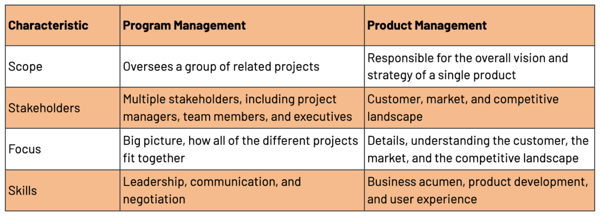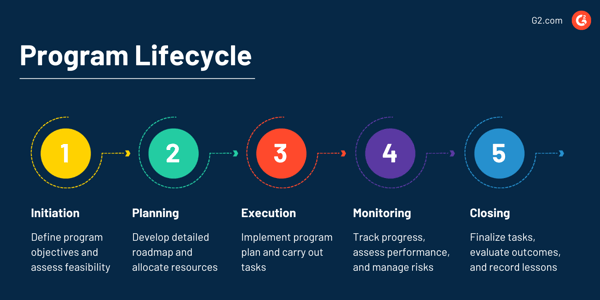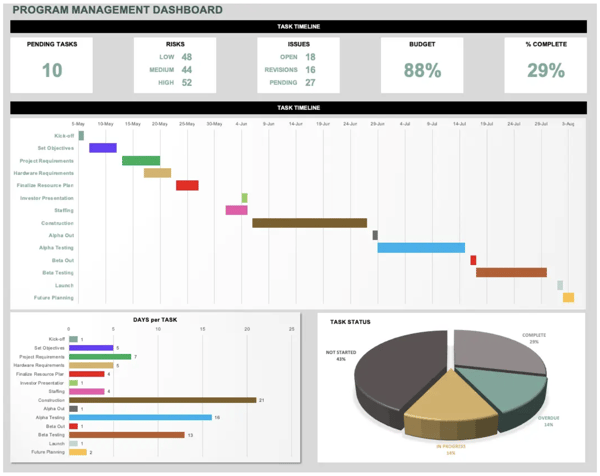July 24, 2023
 by Harshita Tewari / July 24, 2023
by Harshita Tewari / July 24, 2023

Are you feeling overwhelmed by the number of projects you're juggling? Like you're constantly trying to keep track of multiple projects, all with different deadlines and stakeholders? If so, you're not alone.
This is where program management can help you out.
Program management is about understanding the big picture, communicating effectively, identifying risks, and mitigating problems before they happen. And it's about using the right tools and techniques to get the job done.
One of the tools that program managers swear by is program management software. It automates several tasks, such as scheduling, budgeting, and communication, while tracking progress and identifying potential problems early on. This frees up your time to focus on the program's more strategic aspects and deliver complex projects on time, within budget, and to the required quality standards.
Program management is the process of coordinating and managing multiple projects to successfully deliver complex initiatives. It involves defining the program scope and objectives, developing a plan, managing the budget and resources, communicating with stakeholders, and ensuring the program's success.
In this article, we'll examine what program management is and why it's important. We'll also discuss some key skills and tools you need to be a successful program manager.
So whether you're feeling overwhelmed by your workload or just interested in learning more about this domain, read on for some helpful insights.
Project management and program management are closely related disciplines essential for achieving organizational goals. However, there are a few notable differences between the two fields.
Project management is the process of planning, organizing, and managing resources to achieve a specific goal. Projects are typically temporary, with a defined start and end date.
Program management is the process of overseeing and coordinating multiple projects to achieve a common goal. Programs are typically more elaborate than projects and may involve multiple teams, departments, or organizations.
Below are some of the key differences between project management and program management.
The following table summarizes the key differences between program management and product management:

The program lifecycle is the process that a program goes through from start to finish. The entire process is dynamic, and you may need to go back and revisit previous phases if necessary.
For example, if new requirements or market trends like incorporating augmented reality (AR) emerge during the development of a mobile application, the team may need to go back to the initiation phase to revise aspects like the program’s scope, budget, and timeline.
Managing the program lifecycle effectively ensures that you have a structured approach to achieving your program's goals, overcoming challenges, and delivering successful outcomes.

In today's bustling business environment, it's more important than ever to have a robust program management process in place. It provides a systematic approach to strategic planning, organizing, and managing project resources. Various organizations, from large enterprises to government agencies to non-profit organizations, benefit from proper planning and execution.
Here are some examples of how program management can be used in different scenarios.
Read more about KPIs for program management for different industries.
A program manager is responsible for the planning, execution, and delivery of complex projects. They work with various stakeholders and are responsible for bringing together a program's different elements. As a program manager, you must ensure that the program meets its objectives and stays on track.
You must see the big picture and understand how individual projects fit into the program. The specific responsibilities will vary depending on the organization and the program.
However, some typical program manager duties are:
Program management offers many benefits beyond simply reducing the workload of program managers. It provides a comprehensive, structured approach to managing multiple related projects and sets you up for success by preparing you to respond effectively to the changing business environment.
While program management brings numerous benefits, you might encounter challenges managing resources, risk, and changing requirements. Here are some common challenges people face regardless of their industry.
Despite the challenges, overcoming them can lead to successful program outcomes and the realization of benefits for the organization.
By implementing these strategies, you can overcome common challenges and steer the program toward successful outcomes.
Program management templates provide a framework for defining the program, identifying stakeholders, managing risks, and communicating with stakeholders.
Program managers of all levels of experience can use these templates. For new managers, it provides a roadmap for managing a program, and for experienced program managers, a way to ensure that they follow best practices.
The templates you use will depend on the size and complexity of your program, as well as your organization's specific needs. Linked below are 14 free program management templates by Smartsheet that you can use as a starting point.
 Source: Smartsheet
Source: Smartsheet
Program management is a complex and challenging field, but by following certain best practices, you can improve the chances of your success. These best practices provide a foundation; however, they should be tailored and customized to meet your organization and program's specific needs and context.
Program management tools are software applications that can help program managers to plan, track, and manage their programs. They are a valuable asset for program managers, as they can help to save time and effort, improve communication, and increase visibility and transparency.
Various program management tools are available, from simple tools to more complex enterprise resource planning (ERP) systems. The specific tools used will vary depending on the size and complexity of the program, the resources available, and the experience of the program manager.
Some of the most common features of program management tools include:
Multiple tools come under the greater realm of program management software. G2 hosts several categories under program management, including, but not limited to:
Capital management software helps manage capital investments and financial resources. In the context of program management, capital management software enables program managers to track project costs, analyze financial performance, allocate funds to individual projects, and make informed decisions regarding resource allocation.
It plays a crucial role in optimizing the utilization of financial resources, aligning financial objectives with program goals, and enhancing the overall financial performance of programs. It can be used standalone or as a part of other program management software.
*These are the leading capital project software solutions from G2’s Summer 2023 Grid® Report.
Kanban project management software facilitates the implementation of the Kanban method for project management. Kanban is an agile approach that visualizes work using a kanban board, where tasks are represented as cards that move across columns to indicate their progress.
Program managers can use kanban software to visualize the program's workflow, allocate resources, monitor project status, and ensure smooth coordination among different projects within the program. By utilizing kanban project management software, program managers can gain greater visibility into the program's progress, identify bottlenecks, and optimize resource allocation, resulting in improved program performance and successful delivery of program objectives.
*These are the leading kanban project management software solutions from G2’s Summer 2023 Grid® Report.
Project management software is designed to assist in planning, organizing, and overseeing the execution of projects. It provides functionalities like task management, scheduling, resource allocation, collaboration, and progress tracking. It supports the management of multiple projects within a program. This software enables program managers to streamline project management processes, improve coordination, and successfully deliver program goals and objectives.
*These are the leading project management software solutions from G2’s Summer 2023 Grid® Report.
Resource management software helps organizations plan, allocate, and optimize resources such as people, equipment, and materials across projects and programs. By using this software, program managers can balance workloads, prevent resource conflicts, ensuring the optimal utilization of resources throughout the program. It ultimately supports you in achieving program objectives by maximizing resource productivity, minimizing bottlenecks, and maintaining a strategic alignment between resource availability and project demands.
*These are the leading resource management software solutions from G2’s Summer 2023 Grid® Report.
Work management software simplifies and optimizes the management of tasks, projects, and workflows. It provides task tracking, collaboration, document sharing, scheduling, and reporting features. It helps program managers oversee the execution of various projects within a program. You can create and assign tasks, track project progress, monitor deadlines, collaborate with teams, and assess overall program performance.
*These are the leading work management software solutions from G2’s Summer 2023 Grid® Report.

Got more questions? We've got you covered. In this section, we'll cover some of the most commonly asked questions about program management and the related fields.
Q: What is the difference between program management and a program management office (PgMO)?
A: Program management is a strategic approach to managing a group of related projects to achieve a common goal. A program management office (PgMO) is a centralized unit within an organization that supports programs and program managers.
PgMO is sometimes called PMO, which is not the correct abbreviation. PMO stands for project management office, a dedicated group that defines project management standards for an organization.
Q: How does project portfolio management (PPM) differ from program management?
A: Project portfolio management manages a collection of projects and programs to ensure they align with the organization's strategic goals. PPM helps identify gaps in the current project portfolio or projects that may hamper the broader organizational initiatives.
On the other hand, program management focuses on managing a group of related projects, known as a program to fulfill relatively shorter-term objectives.
Q: What distinguishes a project manager from a program manager?
A: A project manager manages individual projects, while a program manager oversees multiple related projects within a program to achieve broader strategic goals.
Q: What are the key elements of program management?
A: Key elements of program management include strategic alignment, stakeholder engagement, program governance, resource management, risk management, and benefits realization.
Q: What are the steps involved in program management?
A: Program management typically involves stages such as program initiation, planning, execution, monitoring and control, and closure. These stages ensure systematic management and successful delivery of program objectives.
Program management is not just about managing projects. It is about managing people, resources, and risks. It is about delivering results on time and within budget. It is also about making a difference.
Program managers play a crucial role in overseeing and delivering successful programs. Invest time exploring tools like program management software that fits your needs to maximize success and drive excellence in your programs. It's also important to be patient and persistent and to learn from mistakes. If you're willing to put in the work, achieving your organizational goals is guaranteed.
Ready to track the success of your program? Objective and key results (OKR) software helps align program objectives, track key results, and monitor progress toward your goals.
Harshita is a Content Marketing Specialist at G2. She holds a Master’s degree in Biotechnology and has worked in the sales and marketing sector for food tech and travel startups. Currently, she specializes in writing content for the ERP persona, covering topics like energy management, IP management, process ERP, and vendor management. In her free time, she can be found snuggled up with her pets, writing poetry, or in the middle of a Netflix binge.
Developing software applications is a complex activity. You need to build many things that...
 by Aaron Walker
by Aaron Walker
Customers are the fuel of any business. They drive the revenue that organizations need to grow...
 by Harshita Tewari
by Harshita Tewari
What is program management? Program management is a process of managing multiple individual...
 by Holly Landis
by Holly Landis
Developing software applications is a complex activity. You need to build many things that...
 by Aaron Walker
by Aaron Walker
Customers are the fuel of any business. They drive the revenue that organizations need to grow...
 by Harshita Tewari
by Harshita Tewari


